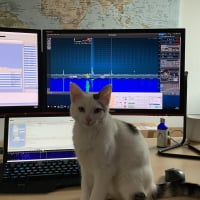SmartSDR v4.1.3 | SmartSDR v4.1.3 Release Notes
SmartSDR v3.10.15 | SmartSDR v3.10.15 Release Notes
The latest 4O3A Genius Product Software and Firmware
Need technical support from FlexRadio? It's as simple as Creating a HelpDesk ticket.
The NEW Voice Keyer WORKS!

Contest Voice Keyer for SmartSDR
This is an update for an old topic
https://community.flexradio.com/flexradio/topics/voice_keyer_for_smartsdr
One of my excuses for not winning a major contest with the Flex 6000 was the lack of an efficient Voice Keyer
Boy was I wrong!!!!!
There is a voice keyer methodology – it was documented in the manual but nobody realized it was there.
First:
Ray K9DUR has written a good voice keyer for PowerSDR and SmartSDR
However it requires focus to be on the voice keyer and mouse clicks to activate voice
Not going to work efficiently in the heat of a contest where every microsecond seems to count and the chance of operator error increases with every mouse or hand movement.
Second:
Writelog – which I have used forever- and most other Contesting Programs such as N1MM+ have efficient keyboard-initiated voice keyers.
But the issue was how to interface them into SmartSDR
Solution: (A previously undocumented feature)
1. When your TX slice is NOT in DIGU/DIGL (e.g. SSB) then you can enable DAX to feed voice keyer audio to DAX.
2. When you need the MIC audio to 'overwrite' the DAX stream you key the radio from a hardware PTT ( MIC PTT on the front connector, the ACC port or the RCA PTT via (say a footswitch) in the back of the radio ).
3. The PTT Action will cause your currently selected microphone input to be routed for TX instead of the DAX stream.
I have done detailed write ups for Both Writelog and N1MM+
Here are some screen shots of the setup for Writelog which allows you to record 20 different audio messages. I used an inexpensive Logitech USB headset to record the messages - Not true ESSB audio but Heck .. it’s a contest.. Nobody has ESSB audio in a contest
The mechanism I show will likely work for virtually every other contesting program that includes an internal voice keyer.
WRITELOG SETUP
1. Set up Writelog to respond to the Windows Sound Board
2. Select the messages you are going to store

The Writelog Help Files will show you how to record message.. Recordings are made by the Windows default headset NOT your Flex connected Microphone
EG. Shift +F2 = Records MSG2.WAV
F2 = Plays back MSG2.WAV
3. Set up DAX to send and Receive Sound via DAX1
4. Select DAX TX1 as the Default Output

5.Enable BOTH DAX AND VOX in the Control Panel

Operations
1. You can record up to 20 different voice messages.. good for more than you will ever use.
2. Shift + Function Key (2-11 to record)
3. Function Key 2-11 to Playback
4. To use the Microphone to speak – just hit PTT
N1MM+ Setup
1. Configure Audio Tab to DAX1

2. Store your messages - Control + Shift+ Function Key- Records on the Fly
Or better – prerecord your messages and store them in the N1MM+ Wave Directory

Repeat Steps 3, 4, and 5 as for Writelog
A suggested addition to the N1MM+ write up by Stu K6TU
If you set the CAT to Flex5000RX2, N1MM+ will run the radio in SO2V mode with a log entry window (including correct TX selection by “VFO” mapped to slices) for each “VFO”.
In the audio setup portion of the config dialog, you need to select two different TX DAX devices - one for each “VFO” AND then select the option “2 - Two radio, Output left channel on left radio, right channel on right radio” in the master drop down list at the top.
This will correctly send DAX driven voice keying on either slice A or slice B - be sure to make sure that the TX button is enabled for EACH channel in the DAX control panel.
The Manual
This is sort of explained in the SmartSDR Users Manual on Page 103
Note: The previous audio input source that you had selected in the dropdown box for audio will be used in situations where you initiate PTT with the front MIC or RCA jack on the back of the radio and you are in SSB, AM, FM, SAM.
FEATURE REQUEST
The issue for contesting with the audio is that:
1. We need also to have a way to easily record the Equalized and Processed Audio
a. The Voice Keyer Audio must be Equalized and Processed so that it can be heard through the din of the Contest
b. The Voice Keyer Audio must sound exactly the same as Spoken Responses from the 6000 so as not to confuse the listener on the other end of the Q so that the contester does not lose contacts.
2. The ideal thing would be to be able to have a mechanism to save the Equalized Processed Voice Recorder Signals as .WAV files directly from the Radio
Finally
Overall the Voice Keyer turned out to be incredibly simple…
Special Thanks to Ed Gonzalez of Flex Radio for leading me in the right direction.
A PDF of this may be found in my Dropbox at:https://www.dropbox.com/s/znrb61i5b57mrtt/Contest%20Voice%20Keyer%20for%20SmartSDR.pdf?dl=0
Comments
-
Howard, I have used my Heil mike on BAL input along with either K9DUR's Voice Keyer, or the audio drivers in N1MM+ several times. yes it works. I would add, however, that after recording your voice keyer files, run them through Audacity and Equalize them for contest audio, and add a little compression. I use about 5:1 on Audacity. It really helps. I have been able to get it to sound very close to my "DX profile" on the Flex.0
-
VERY nice job, Howard !! 73
0 -
Thanks, Howard. What you provided is very useful. Now, after I get a foot switch for PTT and properly mount a microphone, I will actually be able to make a serious effort in SSB contests.0
-
Perfect as usually Howard, Tank you!0
-
UPDATE: The latest release V.1.4.3 has changed this. DAX input on SSB is now PRE-EQ and PRE Processing. It is no longer necessary to EQ and Compress your Contest recordings before using them. My latest test, with recordings from my PR22 via my Behringer Xenix 802USB mixer and Audacity with no processing, other than leveling the audio to bring it up to the proper level, sounded EXACTLY like my live mike in all of the various profiles I tried - Rag Chew, DX, DX/Contest Narrow, etc. I was listening to my 6500 on my 1500 for these tests. This is a great addition! Thanks FRS.1
-
I have updated the .PDF to include the Ken's discovery of the fact that DAX is now also Equalized and Processed when using SSB which removes the need to save special WAV files for the Voice Keyer.
Further since the Slice Record and Playback Functions in 1.4.2 also save Equalized and Processed Audio you no longer need a second receiver or a third party to listen to your Contest Audio..
Overall this is a a major upgrade in the contesting capability of the 6000 series.
The revised PDF with detailed instructions may be found at:
https://www.dropbox.com/s/znrb61i5b57mrtt/Contest Voice Keyer for SmartSDR.pdf?dl=0
0 -
You do such a great job on you articles Howard....
1 -
Howard, Thanks for the article. Now I need to get things lined up to be able to record from within N1MM+. To date I have been recording with Audacity. But at least now I don't need to do any external processing of the recordings! Now that all my Holy Week and Easter services are done, I can spend some more time playing.....with this, my antenna, and the MIDI Controller projects. Right now, the MIDI a Controllers have been the most fun!0
-
Howard,
The PDF you posted on Dropbox is excellent, most appreciated.
I have an addition that you might take a look at for recording with your mic.
The difficulty is with the method required to intertface the station mic to the Default Windows mic input
(temporarily) to do the recording only.
Here it is as follows:
(((True about the Windows default headset but the following is what I am doing.)))
I have a Heil HC4 DX Dream cartridge in a boom mic.
I plug the 1/8" plug from the mic into a Heil mic to Yaesu adapter into the front of the Flex 6300.
>>>To do the recordings with the Heil HC4 mic I temporarily plug the HC4 mic into the
Windows default headset (mic input) on the front of my desktop computer
via an extension cable with 1/8" male on one end and an 1/8" female on the other end.
Other mics would require the appropriate adapter method.
Thanks for all you are doing in the Community site.
73'
Clay N9IO0 -
Howard, have you figured out a way to do this on Lan Remote, in particular having the mic being the default device? just curious.0
-
I am wondering if there are any updates on this thread, it has been two years. Is Voice Keyer the recommended DVK for Flex 6000 ?
Andy K3UK
0 -
It depends on several factors. Many logging/contesting programs incorporate their own voice Keyer functions. For them, use your DAX Mic Stream as your mike recording input, and use DAX TX Audio for the playback channel. Most of the contest programs like writelog, N1MM+, etc. will work. Many general purpose loggers do also. N3FJP 5.8 was recently released and incorporate not only a voice Keyer that works with the 6000 series, but also now works with the TCP ports. If none of your loggers incorporate their own voice Keyer, then K9DUR's voice Keyer works very nicely, but you need to record your .wav files with a program like Audacity.0
-
Thanks for the article.
I took the concepts for Audacity and WriteLog and applied them to N3FJP's ACLog. It works fine.
1. Record a .wav file using Audacity. Save it with a meaningful name.
2. In ACLog, choose Settings>Transmit>Phone Setup...
3. Select the com port used for PTT for Com Port
4. Select DAX Audio TX for your Sound Card
5. For each F Key, browse for the appropriate .WAV file recorded in step 1.
6. Click on Save Settings and provide a file name.
ACLog allows room for 12 announcements using F1 - F12.
0 -
Hi,
i don't get it.
Activating DAX and VOX is bringing the Mic Audio in the air, but working with VOX is really not my thing, and working in VOX Mode is what i have to do then actually.
What i don't understand is, why is the the N1MM Voive Keyer working (DAX is switching with sending the Voicemessage) and the K9DUR not?
It's a really nice peace of software, but the devil is in the detail (DAX).
73' , Stefan
0 -
The Microphone (MOX) should have priority over DAX. This way you could have DAX enabled and use the Mic at the same time (without VOX)
0
Leave a Comment
Categories
- All Categories
- 379 Community Topics
- 2.1K New Ideas
- 631 The Flea Market
- 8.2K Software
- 123 SmartSDR+
- 6.4K SmartSDR for Windows
- 183 SmartSDR for Maestro and M models
- 430 SmartSDR for Mac
- 271 SmartSDR for iOS
- 259 SmartSDR CAT
- 193 DAX
- 382 SmartSDR API
- 9.3K Radios and Accessories
- 39 Aurora
- 265 FLEX-8000 Signature Series
- 7.2K FLEX-6000 Signature Series
- 948 Maestro
- 56 FlexControl
- 866 FLEX Series (Legacy) Radios
- 925 Genius Products
- 463 Power Genius XL Amplifier
- 337 Tuner Genius XL
- 125 Antenna Genius
- 297 Shack Infrastructure
- 209 Networking
- 460 Remote Operation (SmartLink)
- 144 Contesting
- 788 Peripherals & Station Integration
- 139 Amateur Radio Interests
- 1K Third-Party Software






